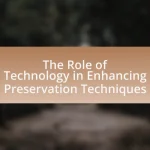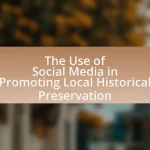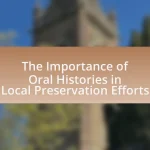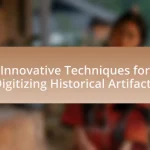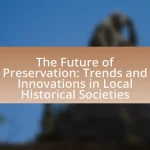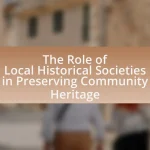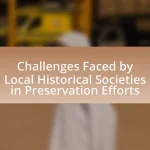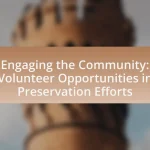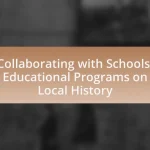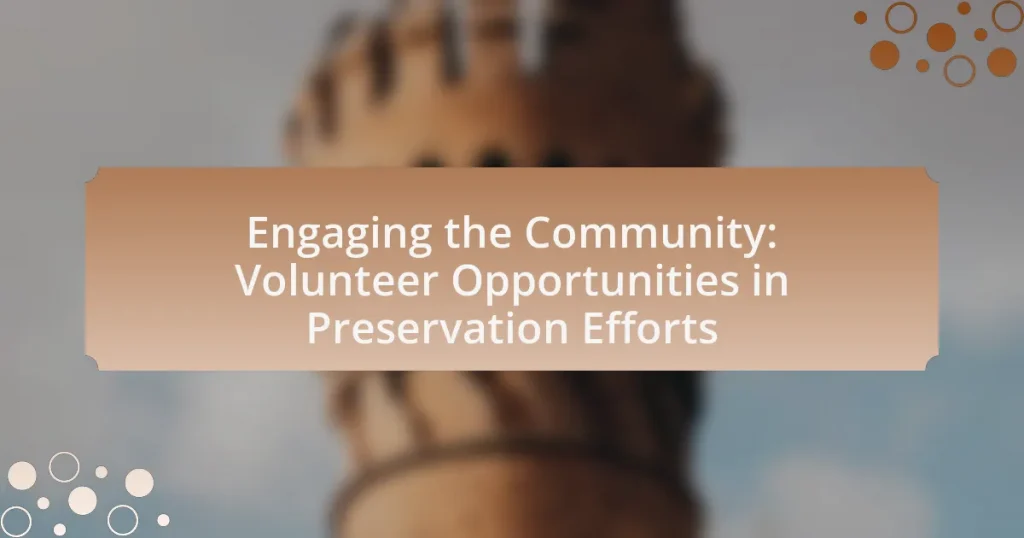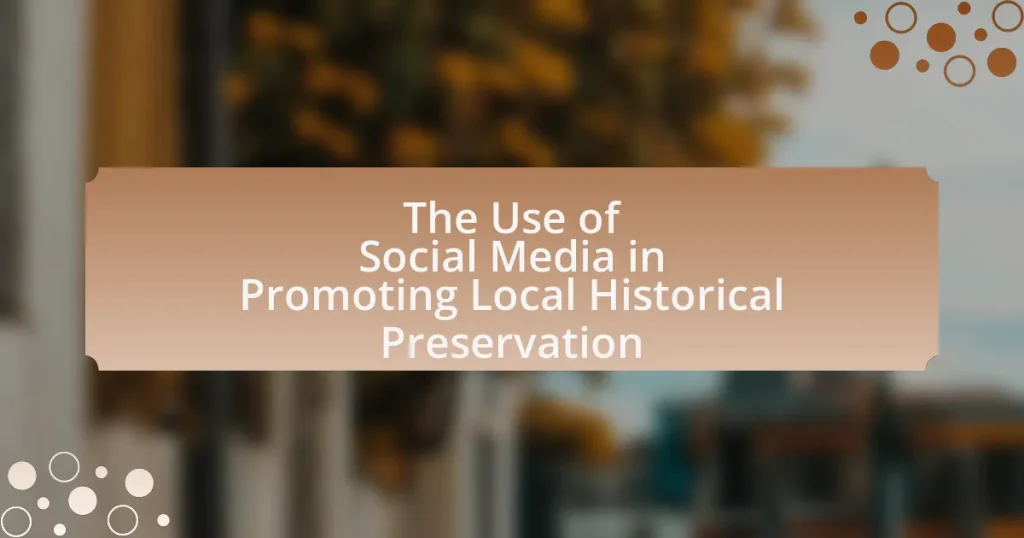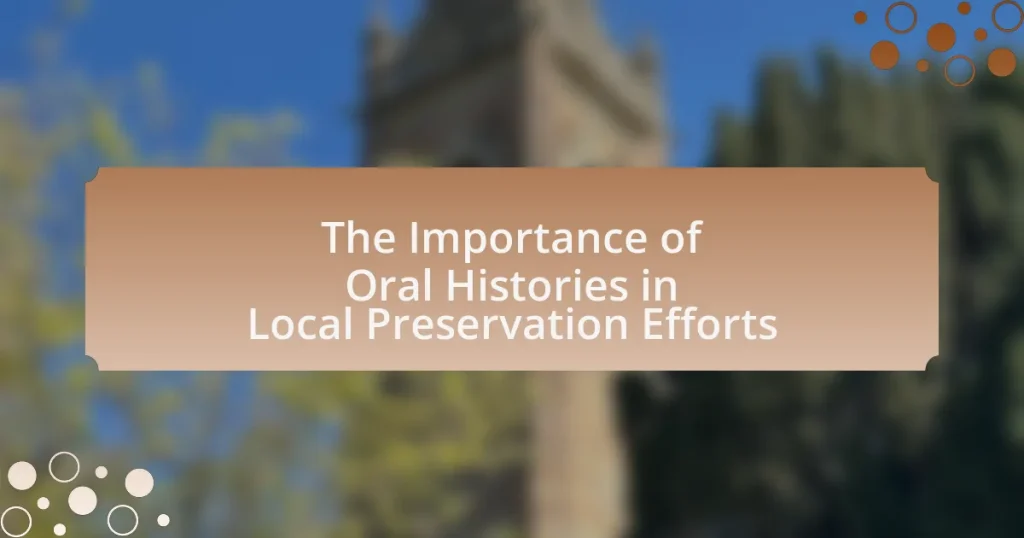The article focuses on volunteer opportunities in preservation efforts, highlighting activities such as habitat restoration, historical site maintenance, and community education programs. It discusses how these opportunities engage the community, enhance local heritage preservation, and foster social cohesion. Key topics include the types of preservation efforts available for volunteers, the importance of community engagement, the skills and resources needed, and the long-term benefits of volunteering. Additionally, the article outlines how individuals can get involved, the challenges they may face, and the support systems available to enhance their volunteer experience.
What are Volunteer Opportunities in Preservation Efforts?
Volunteer opportunities in preservation efforts include activities such as habitat restoration, historical site maintenance, and community education programs. Organizations like the National Trust for Historic Preservation and local conservation groups often seek volunteers to assist in restoring natural habitats, maintaining historic buildings, and conducting educational workshops to raise awareness about preservation. For instance, the National Park Service frequently organizes volunteer days where individuals can help with trail maintenance and invasive species removal, contributing directly to the preservation of natural and cultural resources.
How do these opportunities engage the community?
Volunteer opportunities in preservation efforts engage the community by fostering active participation in local heritage and environmental conservation. These initiatives encourage community members to collaborate on projects that enhance their surroundings, such as restoring historical sites or participating in clean-up drives. Research indicates that community engagement in such activities leads to increased social cohesion and a stronger sense of belonging, as evidenced by a study published in the Journal of Community Psychology, which found that 75% of participants reported feeling more connected to their community after volunteering.
What types of preservation efforts can volunteers participate in?
Volunteers can participate in various preservation efforts, including habitat restoration, historical site maintenance, and community education programs. Habitat restoration involves activities such as planting native species, removing invasive plants, and restoring wetlands, which contribute to biodiversity and ecosystem health. Historical site maintenance includes tasks like cleaning, repairing, and preserving artifacts and structures, ensuring that cultural heritage is protected for future generations. Community education programs focus on raising awareness about preservation issues, engaging local residents in conservation practices, and promoting sustainable behaviors. These efforts are vital for maintaining ecological balance and cultural heritage, as evidenced by numerous successful volunteer-led initiatives across the globe.
How do volunteers contribute to local heritage preservation?
Volunteers contribute to local heritage preservation by actively participating in restoration projects, educational programs, and community events that promote awareness of cultural significance. Their involvement helps to maintain historical sites, document local history, and engage the community in preserving traditions. For instance, organizations like the National Trust for Historic Preservation report that volunteer efforts can significantly reduce costs associated with restoration and maintenance, allowing more resources to be allocated towards preserving heritage sites. Additionally, studies show that communities with strong volunteer engagement in heritage activities often experience increased public interest and support for preservation initiatives, reinforcing the importance of volunteer contributions.
Why is community engagement important in preservation efforts?
Community engagement is crucial in preservation efforts because it fosters local ownership and stewardship of cultural and natural resources. When community members actively participate, they contribute valuable insights and knowledge about their heritage, which enhances the effectiveness of preservation initiatives. Studies have shown that projects involving community input are more likely to succeed, as they align with the values and needs of the local population, leading to increased support and sustainability. For instance, the National Trust for Historic Preservation emphasizes that community-driven projects often result in stronger emotional connections to the preserved sites, ensuring ongoing care and advocacy.
What impact does community involvement have on preservation outcomes?
Community involvement significantly enhances preservation outcomes by fostering local stewardship and increasing public awareness. Engaged communities are more likely to advocate for and participate in preservation efforts, leading to better maintenance and protection of cultural and natural resources. Research indicates that projects with strong community participation often see higher success rates; for instance, a study by the National Trust for Historic Preservation found that community-led initiatives resulted in a 30% increase in project sustainability compared to those without local involvement. This active participation not only ensures that preservation efforts align with community values but also builds a sense of ownership, which is crucial for long-term success.
How does engaging volunteers enhance awareness of preservation issues?
Engaging volunteers enhances awareness of preservation issues by actively involving them in hands-on activities that highlight the importance of conservation. When volunteers participate in preservation projects, they gain firsthand experience and knowledge about the challenges and significance of protecting cultural and natural resources. Research indicates that individuals who engage in volunteer work are more likely to develop a deeper understanding of environmental and historical issues, as they witness the impact of their efforts and the necessity for ongoing preservation. For example, a study published in the Journal of Environmental Management found that community-based volunteer programs significantly increased participants’ awareness and concern for local environmental issues, demonstrating a direct correlation between volunteer engagement and heightened awareness of preservation challenges.
What skills and resources do volunteers need for preservation efforts?
Volunteers need skills in communication, teamwork, and specific technical abilities related to preservation, such as historical research, conservation techniques, and project management. Effective communication skills enable volunteers to engage with the community and stakeholders, while teamwork is essential for collaborative efforts in preservation projects. Technical skills, such as knowledge of archival methods or restoration practices, are crucial for the hands-on aspects of preservation. Resources required include access to training programs, tools for restoration, and materials for documentation. For instance, organizations like the National Trust for Historic Preservation provide training and resources that enhance volunteer capabilities in these areas.
How can volunteers acquire the necessary skills?
Volunteers can acquire the necessary skills through targeted training programs and hands-on experience. Organizations often provide workshops, seminars, and online courses that focus on specific skills relevant to preservation efforts, such as project management, historical research, and conservation techniques. Additionally, volunteering alongside experienced professionals allows individuals to learn practical skills in real-world settings, enhancing their capabilities. For instance, a study by the National Park Service highlights that structured volunteer training significantly improves skill acquisition and retention among participants.
What training programs are available for aspiring preservation volunteers?
Various training programs are available for aspiring preservation volunteers, including workshops, online courses, and hands-on training sessions. Organizations such as the National Trust for Historic Preservation offer educational resources and training opportunities focused on preservation techniques, community engagement, and advocacy. Additionally, local historical societies and preservation organizations often provide volunteer training programs that cover topics like restoration methods, historical research, and preservation planning. These programs equip volunteers with the necessary skills and knowledge to contribute effectively to preservation efforts in their communities.
How can volunteers leverage their existing skills in preservation projects?
Volunteers can leverage their existing skills in preservation projects by applying their specific expertise to enhance project outcomes. For instance, individuals with backgrounds in architecture can contribute to the restoration of historical buildings, while those skilled in graphic design can create informative materials that promote preservation efforts. This alignment of skills with project needs not only increases efficiency but also enriches the overall quality of the work being done. Studies show that utilizing volunteers’ unique skills leads to more successful project implementations, as evidenced by the National Trust for Historic Preservation, which highlights that community engagement through skill-based volunteering significantly improves preservation outcomes.
What resources are available to support volunteers in preservation efforts?
Volunteers in preservation efforts can access various resources, including training programs, informational materials, and community networks. Organizations such as the National Trust for Historic Preservation provide online resources, workshops, and guides that equip volunteers with the necessary skills and knowledge for effective preservation work. Additionally, local historical societies often offer volunteer opportunities and resources tailored to specific community needs, fostering collaboration and support among volunteers. These resources enhance the capacity of volunteers to contribute meaningfully to preservation initiatives.
What organizations provide tools and materials for preservation projects?
Organizations that provide tools and materials for preservation projects include the National Trust for Historic Preservation, the American Institute for Conservation, and the National Park Service. The National Trust for Historic Preservation offers resources and grants to support preservation efforts across the United States. The American Institute for Conservation provides guidelines and materials for the conservation of cultural heritage. The National Park Service supplies technical assistance and funding for preservation projects related to national parks and historic sites. These organizations play a crucial role in facilitating preservation initiatives through their resources and expertise.
How can volunteers access funding or grants for their initiatives?
Volunteers can access funding or grants for their initiatives by researching and applying to various grant programs specifically designed for community projects. Numerous organizations, such as the National Endowment for the Arts and local community foundations, offer grants that support volunteer-led initiatives. Additionally, platforms like GrantWatch and Foundation Center provide databases of available grants, allowing volunteers to identify funding opportunities that align with their projects. According to the National Council of Nonprofits, many grants require a clear project plan and measurable outcomes, which can enhance the chances of securing funding.
How can individuals get involved in preservation volunteer opportunities?
Individuals can get involved in preservation volunteer opportunities by seeking out local organizations focused on conservation and heritage preservation. Many nonprofits, such as the National Trust for Historic Preservation, offer volunteer programs that allow individuals to participate in restoration projects, educational outreach, and community events. Additionally, local parks and historical sites often have volunteer days where individuals can assist with maintenance and preservation efforts. Engaging with these organizations through their websites or social media platforms can provide information on upcoming volunteer opportunities and training sessions.
What steps should someone take to start volunteering in preservation efforts?
To start volunteering in preservation efforts, an individual should first research local organizations focused on preservation, such as historical societies, conservation groups, or environmental nonprofits. Engaging with these organizations often involves visiting their websites or attending community meetings to understand their missions and volunteer needs.
Next, the individual should reach out to these organizations to express interest in volunteering, inquire about available opportunities, and ask about any required training or orientation sessions. Many organizations provide specific training for volunteers to ensure they are equipped to contribute effectively.
Additionally, the individual can participate in local events or workshops related to preservation to gain experience and network with like-minded individuals. This involvement can lead to more opportunities and a deeper understanding of preservation efforts in the community.
Finally, committing to regular volunteer hours and staying informed about ongoing projects will enhance the individual’s impact and connection to the preservation community.
How can individuals find local preservation projects seeking volunteers?
Individuals can find local preservation projects seeking volunteers by utilizing online platforms, community bulletin boards, and local organizations dedicated to preservation efforts. Websites such as VolunteerMatch and Idealist list various volunteer opportunities, including those focused on preservation. Additionally, local historical societies, environmental groups, and community centers often post volunteer needs on their websites or social media pages. Engaging with these organizations directly can provide information on upcoming projects and volunteer requirements.
What are the best practices for new volunteers in preservation initiatives?
New volunteers in preservation initiatives should prioritize understanding the mission and goals of the organization they are joining. This foundational knowledge enables them to align their efforts effectively with the organization’s objectives. Additionally, volunteers should engage in training sessions to acquire necessary skills and knowledge specific to preservation work, such as historical research methods or conservation techniques.
Networking with experienced volunteers and staff can provide valuable insights and mentorship, enhancing their contributions. Furthermore, maintaining open communication with the organization ensures that volunteers can seek guidance and clarify their roles.
Lastly, volunteers should document their experiences and contributions, as this can help in evaluating the impact of their work and in sharing success stories that may inspire others to join preservation efforts. These practices are supported by various organizations in the field, which emphasize the importance of training, communication, and documentation in effective volunteer engagement.
What are the challenges faced by volunteers in preservation efforts?
Volunteers in preservation efforts face several challenges, including limited resources, lack of training, and community engagement issues. Limited resources often hinder the ability to carry out projects effectively, as volunteers may not have access to necessary tools or funding. Additionally, a lack of training can result in volunteers feeling unprepared for tasks, which can lead to inefficiencies and decreased motivation. Community engagement issues arise when volunteers struggle to connect with local populations, making it difficult to garner support and participation in preservation initiatives. These challenges can significantly impact the success and sustainability of preservation efforts.
How can volunteers overcome common obstacles in preservation projects?
Volunteers can overcome common obstacles in preservation projects by fostering effective communication and collaboration among team members. Establishing clear roles and responsibilities helps to mitigate confusion and ensures that tasks are completed efficiently. Additionally, volunteers can address resource limitations by seeking partnerships with local organizations, which can provide funding, materials, or expertise. Training sessions can also equip volunteers with the necessary skills to tackle specific challenges, such as restoration techniques or project management. Research indicates that community engagement significantly enhances project success rates, as seen in the National Trust for Historic Preservation’s initiatives, which emphasize the importance of volunteer involvement in overcoming barriers to preservation efforts.
What support systems are in place for volunteers facing challenges?
Support systems for volunteers facing challenges include training programs, mentorship opportunities, and access to mental health resources. These systems are designed to equip volunteers with the necessary skills and emotional support to navigate difficulties encountered during their service. For instance, organizations often provide workshops that focus on conflict resolution and stress management, which are crucial for maintaining volunteer engagement and effectiveness. Additionally, many volunteer programs have established peer support networks, allowing volunteers to share experiences and solutions, thereby fostering a sense of community and resilience.
What are the long-term benefits of volunteering in preservation efforts?
Volunteering in preservation efforts provides long-term benefits such as enhanced community cohesion, increased environmental awareness, and the development of valuable skills. Community cohesion is strengthened as volunteers work together towards a common goal, fostering relationships and a sense of belonging. Increased environmental awareness occurs as volunteers gain firsthand knowledge about local ecosystems and conservation practices, which can lead to more sustainable behaviors in their daily lives. Additionally, volunteers often acquire skills in project management, teamwork, and specific preservation techniques, which can enhance their employability and personal growth. Studies have shown that communities with active volunteer programs experience lower crime rates and improved public health, further underscoring the positive impact of such efforts.
How does volunteering contribute to personal growth and community development?
Volunteering significantly contributes to personal growth and community development by enhancing skills, fostering social connections, and addressing community needs. Individuals who volunteer often develop leadership, teamwork, and problem-solving skills, which are essential for personal and professional advancement. For instance, a study by the Corporation for National and Community Service found that volunteers are 27% more likely to find a job after being out of work compared to non-volunteers, highlighting the impact of volunteering on employability.
Additionally, volunteering strengthens community ties by bringing together diverse groups to work towards common goals, thereby fostering a sense of belonging and collective responsibility. Research from the National Conference on Citizenship indicates that communities with higher volunteer rates experience lower crime rates and improved public health outcomes, demonstrating the positive effects of volunteerism on community well-being.
What lasting impacts can volunteers have on their communities through preservation?
Volunteers can have significant lasting impacts on their communities through preservation by enhancing local heritage, fostering community pride, and promoting environmental sustainability. By participating in preservation projects, volunteers help maintain historical sites, which can lead to increased tourism and economic benefits for the community. For example, a study by the National Trust for Historic Preservation found that heritage tourism can generate substantial revenue, with visitors spending an average of $1,000 per trip, benefiting local businesses. Additionally, volunteers often engage in educational initiatives that raise awareness about the importance of preserving cultural and natural resources, thereby instilling a sense of responsibility and stewardship among community members. This collective effort not only safeguards the community’s identity but also strengthens social bonds, creating a more cohesive and resilient community.
What tips can enhance the volunteer experience in preservation efforts?
To enhance the volunteer experience in preservation efforts, organizations should provide clear training and orientation for volunteers. This ensures that volunteers understand their roles, the significance of the preservation work, and the impact of their contributions. Research indicates that well-structured training programs increase volunteer retention rates by up to 50%, as volunteers feel more competent and engaged in their tasks. Additionally, fostering a sense of community among volunteers through team-building activities and regular communication can significantly improve their overall experience, leading to higher satisfaction and commitment to the preservation goals.
